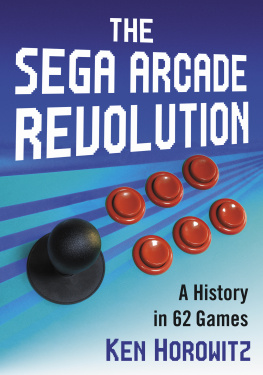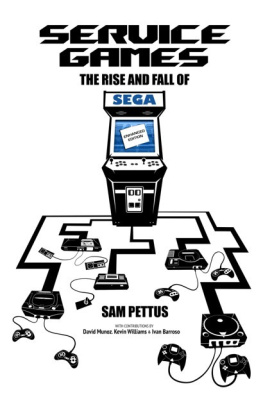Title Page
101 AMAZING SEGA MASTER SYSTEM FACTS
by
Jimmy Russell
Publisher Information
Published in 2012 by
Andrews UK Limited
www.andrewsuk.com
The right of Jimmy Russell to be identified as the Authors of this Work has been asserted by him in accordance with the Copyright, Designs and Patents Act 1998
Copyright 2012 Jimmy Russell
All rights reserved. No part of this publication may be reproduced, stored in a retrieval system, or transmitted, in any form or by any means without the prior written permission of the publisher, nor be otherwise circulated in any form of binding or cover other than that in which it is published and without a similar condition being imposed on the subsequent purchaser. Any person who does so may be liable to criminal prosecution and civil claims for damages.
Disclaimer: Publicly available sources confirm the attribution of these credits, however the authors will be happy to correct any errors. All quotations are subject to applicable fair use laws.
Introduction
In this entry to Jimmy Russells Games Console History series, we learn 101 amazing facts about Segas Master System, the first Sega home console to hit non-japanese shores.
The facts cover many areas, including the history, the hardware, game titles both rare and popular and some incredible information you probably never knew! Everyone from retro gamers who were there at the time to n00bz who think a PlayStation is Old School will find this excellent eBook jam packed full of fascinating trivia!
History I
- In 1983 Hideki Sato designed the Master Systems first iteration, the Sega Game 1000 .
- Launched on July 15th 1983, The SG-1000 wasnt very popular but was Segas first outing into video games hardware.
- Known from then on as the Sega Mark I, two Sega machines followed in its wake (Segas Mark II and III respectively).
- The Sega Mark III launched on October 20th 1985 in Japan and cost 15,000 Yen.
- Sega finally launched the console we know as the Master System in Japan in 1987.
- A year earlier - June 1986 - The Master System had launched in North America to compete with Nintendos NES.
- The console sold in North America for $200.
- Not wishing to take on Nintendo directly, Sega arranged for toy manufacturer Tonka to distribute their console in the USA.
- The Master System suffered from a lack of third-party support due to Nintendos aggressive exclusivity requirements, meaning the console never had the impact it deserved.
- By 1989 the only two third-party companies developing games for the Master System - Parker Brothers and Activision - withdrew their support, further damning the console.
Peripherals
- One of the Master Systems quirkiest peripherals were the 3D Glasses. Supported by only a handful of games the glasses delivered a cool 3D effect that no other console could offer.
- The original standard two-button pad had a hole for a screw-in thumb stick! This was unfortunately removed from later control pads.
- The Control Stick was a huge black-clad joystick, akin to Nintendos Advantage. The strangest part of the Control Stick is that the stick is on the right with the button on the left.
- The Light Phaser was the light gun of choice for Master System players.
- The trackball by Sega is called the Sega Sports Pad and was playable with non-sports games too, if you like.
- The Handle Controller was Segas answer to the arcade steering wheels. Resembling a helicopter control, the wheel also had an LCD display which flashed random numbers for no apparent reason.
- A Master System Floppy Disk Drive was developed in the late eighties to further expand the media the Master System would accept. A prototype was built but the peripheral was unfortunately never released.
- A third-party wireless controller known as the Remote Control System was released by WKK Industries in the early nineties.
- The SG Commander control pad is a Europe and Japan-exclusive control pad. Essentially the same as an original pad, the Commander has turbo fire switches for each button.
- The Master System sported a 50-pin expansion slot which was never utilised. The mind boggles at what was planned!
Hardware I
- The Master System sported a higher colour palette than its rival NES - 64 colours to the NESs paltry 48.
- The original model Master System could play cartridge game and also credit-card-sized Sega Cards which were cheaper, but shorter games.
- Sega Game Cards only held 256 kilobits of data whereas cartridges held at least four times that.
- Master System consoles also featured a built-in game which would play if no game was inserted - the game was different depending on which version of console you owned.
- In 1989 Sega released the Master System II - a low-cost, cut-down unit without a card slot and the now-famous Alex Kidd in Miracle World built-in game.
- The standard controller only features two buttons - the pause button is on the console itself!
- The machine features an Atari-style Kempston screwless 9-pin connector meaning the console is compatible with hundreds of controllers for the Spectrum, Commodore, Amiga and Amstrad computers.
- The Japanese machines had many more accessories such as an FM Sound Unit (which boosted the music and sound considerably) and an RF television tuner called the Mark III Telecon Pack .
- The Power Base Converter was a hardware add-on for the Mega Drive that let users play Master System games on their consoles. Due to the similarity between the consoles, the converter is actually almost entirely passive circuitry, just effectively extending the controller connectors.
- The Master System is 365mm wide, 170mm deep and 69mm tall.
Top-selling Games as of 2013
According to www.retrotrader.com
- Castle of Illusion Starring Mickey Mouse
- The Lucky Dime Caper starring Donald Duck
- Prince of Persia
- Cyber Shinobi
- Bubble Bobble
- California Games
- Chuck Rock
- Gauntlet
- Disneys Jungle Book
- Sagaia
Impact
- The Sega Master Systems sales smashed those of the NES in the PAL and South American territories.
- Due to this higher popularity the console enjoyed over ten years of life in Europe, Oceania and South America.
- Unlike the NES, the Master System brought the arcades into the home with staggeringly accurate ports of R-Type, Ghouls & Ghosts and Fantasy Zone amongst others - this is a trend which Sega proudly continued through to the Dreamcast.
- Unfortunately though the games library was weaker - only around 330 games were released for the Master System, compared to over 500 on the NES.
- Although popular in Europe, the SMS only shifted around two million units in the USA.
- Due to a lucrative licensing deal, the Master Systems Light Phaser appears in the anime Zillion as a real laser gun - complete with the cable!
- Mean Machines Sega , the UK-based gaming magazine was started in 1990 covering the Master System almost exclusively and covered Japanese imports as well as domestic market games. Mean Machines is a fondly-remembered magazine and is a favourite with nostalgic collectors.
- The Sega Game Gear is essentially a handheld Master System, albeit with a few enhanced features and tweaks based on the Master Systems groundwork.
- Until 1994, the SMS was the console with the largest active installed user-base in Europe - 6.25 million active units.
- In fact, the Master System alone accounted for half of all consoles in Europe!
History II
- Come 1989 and after a fairly poor run in North America, Sega prepared to release its new 16-bit machine, the Genesis .
- In 1991 Nintendo was charged for their unfair conduct, which opened up the third-party licenses for Sega. Unfortunately the damage had been done in North America so Sega turned its eye to Europe.
Next page



